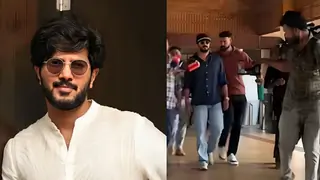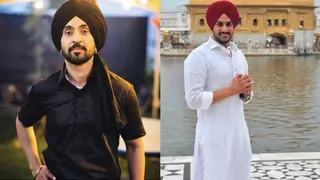Fusing fusion
Percussionist Anoor Anantha Krishna Sharma on walking the fine line
Anoor Anantha Krishna Sharma: 'You can never do 100 per cent justice to either the Western or Carnatic form when you fuse them, but they must gel well.' — Photo: K. Bhagya Prakash
BORN INTO a traditional musical lineage, eminent percussionist Anoor Anantha Krishna Sharma (popularly known as Shivu) is the son of the late Carnatic violinist, Vidwan Anoor S. Ramakrishna. Essentially a classical musician, he is a much respected figure in fusion circles. "My first love is Carnatic concerts. Fusion music is just going on, on the side. I've done music for cassettes; I have composed music for dance, ballet, etc. I was involved in commercial music — like films and albums and had lots of friends who played western instruments. So, we used to jam in someone's place and that kicked off my fusion composing career.
"My father used to play the violin and I learnt Carnatic from him, but as long as I can remember, I have been playing the mridangam. Percussion has been my favourite and it came naturally. I started training under my guru R.A. Rajagopal only at the age of 13. Along with mridangam, I picked up the tabla, dhol, thavil, western drums, etc. Once you learn an Indian percussion instrument, it becomes very easy to master a western one.
"Usually, the perception of fusion music is that all it takes is adding some dhin-chak dhin-chak sort of standard western beats to an alaap. 😆😆 But that is not the only way. Fusion is too abstract to define; there is no definite format to follow. But what I try to do is project classical music in a form that is appreciated by the common man who doesn't care about the raga or the tala. I make sure that I don't touch the traditional kirthanas or varnas, but just use that structure. I have not gone beyond tradition, because in Carnatic or Hindustani music, there are some rules to every raga (like ascending and descending swaras).
"My basic aim is to promote classical Indian music through fusion. So I make sure that the songs retain their traditional values and are not tampered with just for popular appeal. For example, Sahana is one of the hardcore Carnatic ragas and I would never ruin its structure by mixing it with some other raga, however good it might sound. When I take another hardcore raga like Varaali, I know it's not so easy to play on the keyboard or guitar. That is why even for fusion music, it is important to have instrumentalists who understand and accept music of all forms. They must be able to mould the ragas to suit the mood and the need of the fusion number. You can never do 100 per cent justice to either the Western or Carnatic form when you fuse them, but they must gel well.
"There is one limitation in fusion music, though. You cannot suddenly start playing something that is unrehearsed or unplanned. The overall structure is pre-determined and changing it disrupts the entire harmony. But when I perform in a Carnatic concert, I know that I can play around a little bit within the structure.
"As an accompanist, you are always dependent on the main artist who decides how much time to leave for your solo. As a mridangam player, sometimes I feel there isn't enough room in a Carnatic concert for an instrument. I might get only about 15 solo minutes in a 3-hour concert, but some vocalists do understand the value of the instrument and the artistes and allow ample time for the solo instrumental bit.
"People do say that fusion music is not a method of promoting classical music, but that it is actually changing the form itself. They call it a step in the evolution of classical music. Both views are right. That's why we must be careful not to get carried away with the mixing of genres and forget the authentic ones. Eventually, it is only the listening ear that will decide what sounds good and what does not. Ten years from now, I think things will turn much more towards Indian music. The thing that's stopping Carnatic music from becoming popular is that it is very hard to understand, is very orthodox... more than Hindustani music.
"The problem lies with the media also. Except Doordarshan, no broadcaster hosts any show that showcases any classical music or art. People also switch on the radio so rarely; and even when they do, it is an FM channel that plays film and western music.
Even a small advertisement for a little chocolate is westernised. No wonder the majority wants to learn the guitar and drums. That's what they hear all the time, so that's what they know. Media should also expose people to Indian classical music to increase awareness. How many movies can the private channels keep showing? They must expand their programme base.
"When you look at private channels in Tamil Nadu or Kerala, you find quite a lot of promotion for classical music. Karnataka in general lags behind in this. I don't know why... though it is a lot better than the situation 10-15 years back. A number of youngsters want to at least know about their traditional forms of music.
"When you listen to the latest film music these days, a good number of them are classical based. For example, Devdas and even A.R. Rahman's music has a strong classical base. Fusion must blend different forms of music but must keep their distinctive elements alive. That's when it is beautiful. Film music has helped to generate interest classical music."































